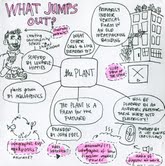
Even writers and brands who understand the importance of digital content and meeting audiences where they live online often have a bit of a learning curve when it comes to understanding digital, and especially visual, media. But mashups of traditional media—text, photos, video and graphics—are increasingly in vogue and more likely to reach certain viewers.
That was the lesson freelance illustrator Joyce Rice wanted to get across, speaking at ASJA’s Content Connections conference on November 8th. Rice discussed the use of storyboards for writers creating content for digital projects. Rice co-founded Symbolia Magazine, a tablet publication that is pioneering illustrated journalism, a format that pairs reported articles with comic-like graphics.
Even if you’re not a visual expert, one tool that can help marketers and freelancers collaborate on content is the storyboard. As written publications move towards hybrid digital media, simply transferring stories from print to online is no longer enough. Rice cited a study by MDG advertising, stating that content featuring compelling images averages a stunning 84 percent more total pageviews than mere text.
Understanding the Differences
Storyboards were originally used in film, to draw out the most important action sequences in a scene in order to help the cinematographer visualize the shots he or she needed.

A typical storyboard from Joyce Rice
In digital content, storyboards can be used in the planning process to isolate the most important steps and then visualize them, creating a map to refer to later on in the process.
Creating a storyboard allows writers to not only visually work through the content creation process, but also to determine which visual elements could accompany a story: a slideshow, a series of photos, an illustration, an infographic or even animation.
Another benefit to mapping out ideas—it provides an opportunity to get feedback, suggestions and ideas from team members focused on individual specialties. It also provides a record of how ideas turned into the finished project, a good starting point for brainstorming the next big piece of content.
Not all publishers or brands are open to ideas about visual elements, but many encourage collaboration between artists and designers and content writers. When illustrators, photographers, audio and video specialists and writers work together to determine a strategy for telling a story, the whole can be greater than the sum of its parts.
“The difference is that you have an infinite canvas. You can write as long as you hold your reader’s interest, and it doesn’t get more expensive,” Rice said.
Storyboarding isn’t just useful for seeing how a written piece will be combined with visual elements on a page. Mind maps, or diagrams to visually outline information, can be used to work through ideas in a story and see which are the most compelling. Communicating complex topics, such as information about diseases, sometimes misses the mark. A long list of symptoms or side effects, for example, is easily glossed over by a busy reader, but visual elements can help drive the point home.







